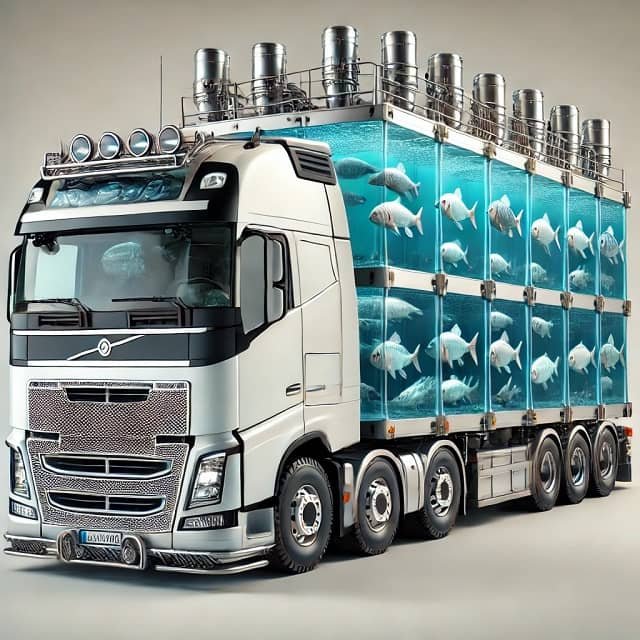
With the support of funding from the European Maritime and Fisheries Fund (FEMP) and a touch of Danish ingenuity, researchers are exploring innovative production techniques that could revolutionize aquaculture as we know it.
Currently, fry production relies almost exclusively on rotifers (microscopic aquatic invertebrates) and Artemia (small crustaceans), which must be enriched with fish oils or algae before use. This process is not only costly and time-consuming but also falls short of providing the ideal nutritional quality for such feeds.
New live food alternative: Enchytraeids
At Aarhus University, researchers supported by EU funds have discovered a way to use decomposing algae to mass-produce marine enchytraeids, small worms naturally found in decaying algae.
The project has demonstrated that feeding on live enchytraeids, also known as white worms, can increase the growth rates of juvenile fish (such as turbot, European plaice, and common whitefish) by up to 200% and reduce overall mortality.
3 good reasons to use these small enchytraeids
- Enchytraeids have an ideal nutrient composition, with high levels of proteins and lipids, along with abundant long-chain omega-3 fatty acids.
- Enchytraeids can be sustainably grown in a terrestrial environment, on industrial organic waste, replacing marine food sources and thereby reducing fishing pressure on the marine environment.
- By using enchytraeids as live food, fish farmers can delay weaning to dry food until the fish are large enough to optimally utilize dry food.
Optimal production conditions
With this project, researchers explored optimal production conditions, developed efficient extraction procedures, and tested the utility of enchytraeids as juvenile feed for six cultured fish species.
Enchytraeus experienced the highest growth rate at temperatures of 15-22 °C and substrate salinity between 8 and 15 parts per billion. In laboratory tests, using potting soil mixed with dried and rehydrated algae as a substrate, approximately 90 g of fresh biomass could be produced per liter of substrate every three months. When scaled up to a semi-industrial level, the team achieved around 200 g of fresh biomass per 6 liters of substrate every two months with minimal labor and low operating costs.
This way, enchytraeids can be sustainably produced in a terrestrial environment, eliminating the risk of disease transfer commonly found in aquaculture live food production.
Stay Always Informed
Join our communities to instantly receive the most important news, reports, and analysis from the aquaculture industry.
Extraction process
Researchers also developed a highly efficient extraction procedure (>90% efficiency) based on heat extraction. Laboratory experiments indicated that Enchytraeus can independently synthesize essential omega-3 fatty acids, making them a valuable protein source for fish feed, with approximately 50% protein in dry weight.
Testing on marine fish
Additionally, the team tested the utility of live enchytraeids as feed for juveniles of six cultured fish species. Turbot, plaice, and whitefish grew significantly better with live worms than with standard dry feed.
“We have shown that feeding on live Enchytraeus albidus can increase the growth rates of juvenile fish (i.e., turbot, European plaice, and common whitefish) by up to 200% and reduce overall mortality,” they reported.
However, even though halibut and ballan wrasse grew equally well, it was determined that enchytraeids were not a suitable live food for the kingfish.
Despite promising results, it is clear that there is a knowledge gap currently limiting the production and use of this live food in the industry.

Conclusion
“Together with ClimateStressLab and project partners, our main goal is to optimize mass production and develop cryopreservation techniques to ensure the storage and transportation of live enchytraeids used as live feed in aquaculture. The ultimate objective is to implement the developed cryopreservation of enchytraeids for industrial use and provide aquaculture producers of juvenile fish with an essential live food product,” state the scientists.
Although additional investments and increased awareness may be necessary for enchytraeids to have the kind of impact researchers envision as possible, the support from the European Maritime and Fisheries Fund was crucial in exploring innovative and sustainable changes in the aquaculture industry.
For more information
Poster of the project: Industrial_PhD_Poster_90x120cm_Mathias Engell Dahl Holmstrup (au.dk)
Note: Prepared with information from Directorate-General for Maritime Affairs and Fisheries
Editor at the digital magazine AquaHoy. He holds a degree in Aquaculture Biology from the National University of Santa (UNS) and a Master’s degree in Science and Innovation Management from the Polytechnic University of Valencia, with postgraduate diplomas in Business Innovation and Innovation Management. He possesses extensive experience in the aquaculture and fisheries sector, having led the Fisheries Innovation Unit of the National Program for Innovation in Fisheries and Aquaculture (PNIPA). He has served as a senior consultant in technology watch, an innovation project formulator and advisor, and a lecturer at UNS. He is a member of the Peruvian College of Biologists and was recognized by the World Aquaculture Society (WAS) in 2016 for his contribution to aquaculture.




